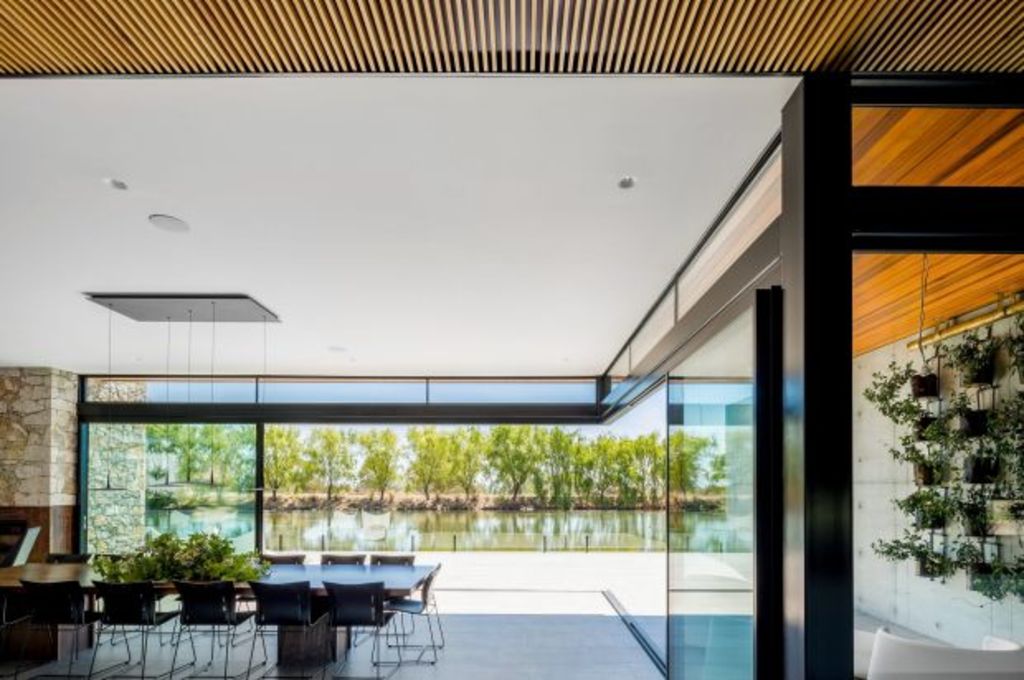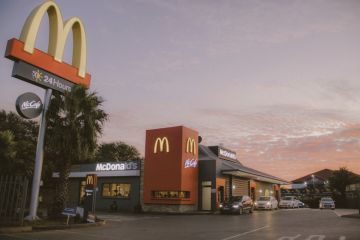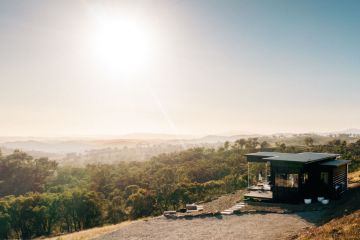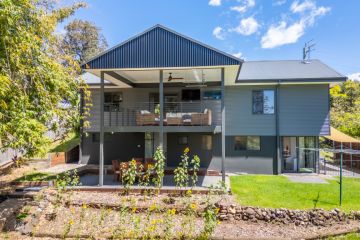'Water literally flows underneath': Is this the country's most beautiful house?

The most straightforward description of Swan House is that it’s a modernist, three-bedroom family home built atop a bridge that crosses a big dam – or small lake – on a property outside Canberra.
Adding atmosphere to that image is that black swans glide on that big dam, which in sunlight reflectively dapples squared white walls that counterpoint full-heights of glass, walls and chimneys clad in grey Monaro Plains granite laid as dry-stone.
Ducks scud to landings on the long stretch of water. Swallows dance and swoop above it.
“There is always some new bird,” says the owner. “As I move through the house there is always something different to see, always something changing,” she says.
This sublime, large-scale home; this apparently floating domestic world, where the owner says, “I can leave my problems behind”, was conjured from a prolonged and creatively complex dance between the owners, who operate a major east-coast concrete formwork company, and Canberra’s Collins Caddaye Architects. It took seven years alone from gaining the commission to design a second home on the 4.85 Googong hectares, to finding the perfect spot for it on the property.
Conceptually, the house started out on a hill to look down on the dam. On the drawing board it progressively moved down the slope until it was on a platform above the 5.5-metre deep dam. “And that was it”, says the owner. “We liked the idea of having water on both sides”.
At age 42, architect Andrew Collins admits that the project that won his practice this year’s ACT chapter AIA award for new residential, may be a career one-off. “Still, to this day, we thank our lucky stars. But the harsh reality is that I know I may never do another house as beautiful as this,” Collins says.
- Related: The renovation of a period pub
- Related: A piece of history polished and revived
- Related: The house that balances on a pole
He will probably never meet clients with such imaginative input either, clients who would often follow up an interesting suggestion with trucks, bringing to site leftover materials from construction jobs their company was working on.
The dam perimeters were stabilised by tonnes of concrete. The granite was fetched from a friend’s Cooma farm. “It became a Sunday job to collect the rocks. And still he wants more,” the owner says of her husband, the insistent re-purposer.
The wooden bridge on the entry road that rumblingly announces guest arrivals is supported by massive steel beams from a crane gantry. The white rendered walls on the southern and western faces of the elegant house are insulation-amping styrene foam panels from a dismantled cold store.
Collins reckons that on a project where “the clients had more fun than we did”, he would arrive on site prepared for any surprise. “It was tightrope walking. We were following their lead, and gently steering them.”
It was so amazing to have clients so insistent on stretching the inventive scope, that Collins says: “When we suggested floating the house between two sides of the dam and they said ‘yeah!’ We could hardly believe it.”
The building begins with a foundation of seven, 300-millimetre concrete piers or blades that allow the living platform to stretch 40 metres from toe-holds of dry land. “Water literally flows underneath.”
Those solid earth touch-downs take shape as broad courtyard aprons laid in a herringbone pattern with blue limestone. Inside, where the central living and kitchen areas have full height, glass side-walls opening to patios, the ceiling is tall and at 10 by 40 metres, the room’s scale commensurate with the furniture and art.
The massive dining table that was a primary priority of the design is made of ironbark timber retrieved (of course) from an old Bungendore bridge. This family entertains a lot. “We can go from two to 20 in a minute,” the owner says.
The floor plan is simplicity itself: four boxy sectors where there are two bedrooms, a snug or cinema room, a very large laundry down one end, and the kitchen and master suite down the other. Transiting the length is a wide corridor over which a ceiling battened in fine timbers implies the circulation path.
There are statement wall sections – near the granite-clad fireplace for instance, where raw form-poured concrete is on display. It’s the heft in an otherwise finely appointed house with acres of cupboards and planes of dark cabinetry.
There is, obviously, no expense spared. There is no end to novel ideas either, as the master suite shows. Within the bedroom complex, the bathroom is open to the sleeping area but partially screened by a central, square, glass box that is open to the sky and planted with trees, ferns and grasses.
The owner tells how poetic it is to see rain falling into it or the full moon rise above the unexpected roof aperture. And on the horizontal living screen through the windows there are the waterbirds to watch.
The architect knows this is a big house, but believes the scale is appropriate to the setting and it is always the landscape that is the most important thing. “It is a house on water in a landscape – a softscape,” he says.
In Australia, Swan House is a one-off. Maybe it’s our lake-calm version of Frank Lloyd Wright’s Fallingwater. Andrew Collins says, “Even my father [Collins Caddaye founder Peter], who has been in the business for 50 years, says he’s never seen anything like it.”
As part of the fifth DESIGN Canberra Festival (November 5-25), two bus tours to four finalist houses from the 2018 ACT Architectural Awards will include Swan House. To take place on November 18 and 25th the tours will be one of the highlights 100 festival including events, exhibitions, talks, markets and more. Click here for bookings.
We recommend
We thought you might like
States
Capital Cities
Capital Cities - Rentals
Popular Areas
Allhomes
More
- © 2025, CoStar Group Inc.






